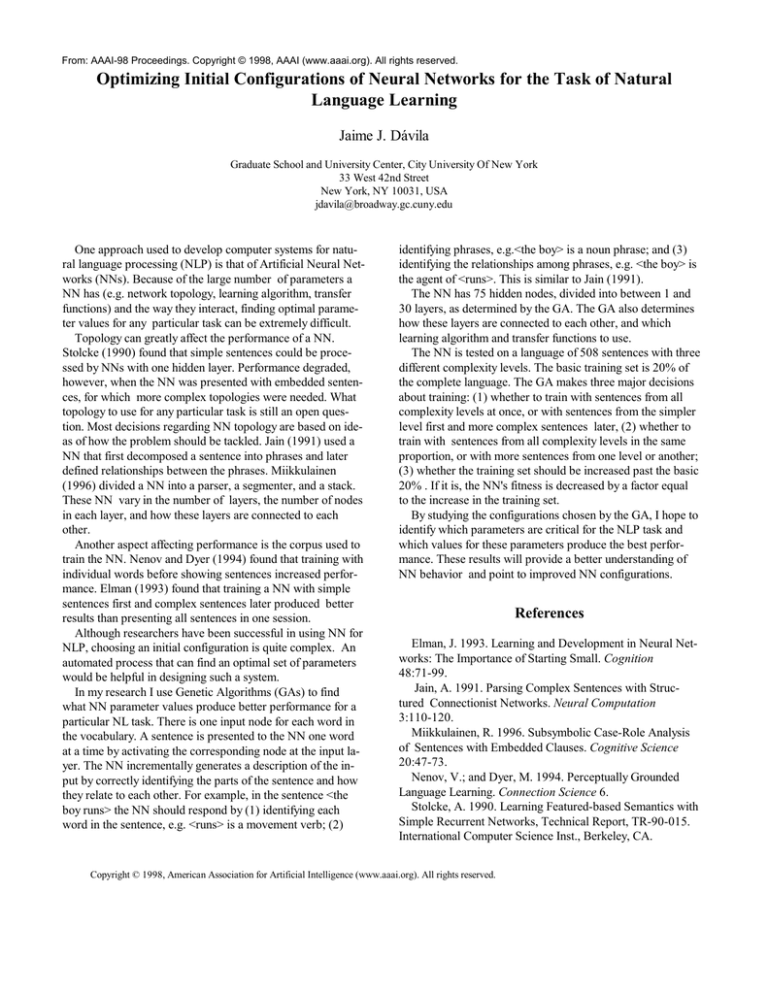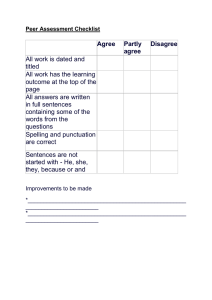
From: AAAI-98 Proceedings. Copyright © 1998, AAAI (www.aaai.org). All rights reserved.
Optimizing Initial Configurations of Neural Networks for the Task of Natural
Language Learning
Jaime J. Dávila
Graduate School and University Center, City University Of New York
33 West 42nd Street
New York, NY 10031, USA
jdavila@broadway.gc.cuny.edu
One approach used to develop computer systems for natural language processing (NLP) is that of Artificial Neural Networks (NNs). Because of the large number of parameters a
NN has (e.g. network topology, learning algorithm, transfer
functions) and the way they interact, finding optimal parameter values for any particular task can be extremely difficult.
Topology can greatly affect the performance of a NN.
Stolcke (1990) found that simple sentences could be processed by NNs with one hidden layer. Performance degraded,
however, when the NN was presented with embedded sentences, for which more complex topologies were needed. What
topology to use for any particular task is still an open question. Most decisions regarding NN topology are based on ideas of how the problem should be tackled. Jain (1991) used a
NN that first decomposed a sentence into phrases and later
defined relationships between the phrases. Miikkulainen
(1996) divided a NN into a parser, a segmenter, and a stack.
These NN vary in the number of layers, the number of nodes
in each layer, and how these layers are connected to each
other.
Another aspect affecting performance is the corpus used to
train the NN. Nenov and Dyer (1994) found that training with
individual words before showing sentences increased performance. Elman (1993) found that training a NN with simple
sentences first and complex sentences later produced better
results than presenting all sentences in one session.
Although researchers have been successful in using NN for
NLP, choosing an initial configuration is quite complex. An
automated process that can find an optimal set of parameters
would be helpful in designing such a system.
In my research I use Genetic Algorithms (GAs) to find
what NN parameter values produce better performance for a
particular NL task. There is one input node for each word in
the vocabulary. A sentence is presented to the NN one word
at a time by activating the corresponding node at the input layer. The NN incrementally generates a description of the input by correctly identifying the parts of the sentence and how
they relate to each other. For example, in the sentence <the
boy runs> the NN should respond by (1) identifying each
word in the sentence, e.g. <runs> is a movement verb; (2)
identifying phrases, e.g.<the boy> is a noun phrase; and (3)
identifying the relationships among phrases, e.g. <the boy> is
the agent of <runs>. This is similar to Jain (1991).
The NN has 75 hidden nodes, divided into between 1 and
30 layers, as determined by the GA. The GA also determines
how these layers are connected to each other, and which
learning algorithm and transfer functions to use.
The NN is tested on a language of 508 sentences with three
different complexity levels. The basic training set is 20% of
the complete language. The GA makes three major decisions
about training: (1) whether to train with sentences from all
complexity levels at once, or with sentences from the simpler
level first and more complex sentences later, (2) whether to
train with sentences from all complexity levels in the same
proportion, or with more sentences from one level or another;
(3) whether the training set should be increased past the basic
20% . If it is, the NN's fitness is decreased by a factor equal
to the increase in the training set.
By studying the configurations chosen by the GA, I hope to
identify which parameters are critical for the NLP task and
which values for these parameters produce the best performance. These results will provide a better understanding of
NN behavior and point to improved NN configurations.
References
Elman, J. 1993. Learning and Development in Neural Networks: The Importance of Starting Small. Cognition
48:71-99.
Jain, A. 1991. Parsing Complex Sentences with Structured Connectionist Networks. Neural Computation
3:110-120.
Miikkulainen, R. 1996. Subsymbolic Case-Role Analysis
of Sentences with Embedded Clauses. Cognitive Science
20:47-73.
Nenov, V.; and Dyer, M. 1994. Perceptually Grounded
Language Learning. Connection Science 6.
Stolcke, A. 1990. Learning Featured-based Semantics with
Simple Recurrent Networks, Technical Report, TR-90-015.
International Computer Science Inst., Berkeley, CA.
Copyright © 1998, American Association for Artificial Intelligence (www.aaai.org). All rights reserved.




